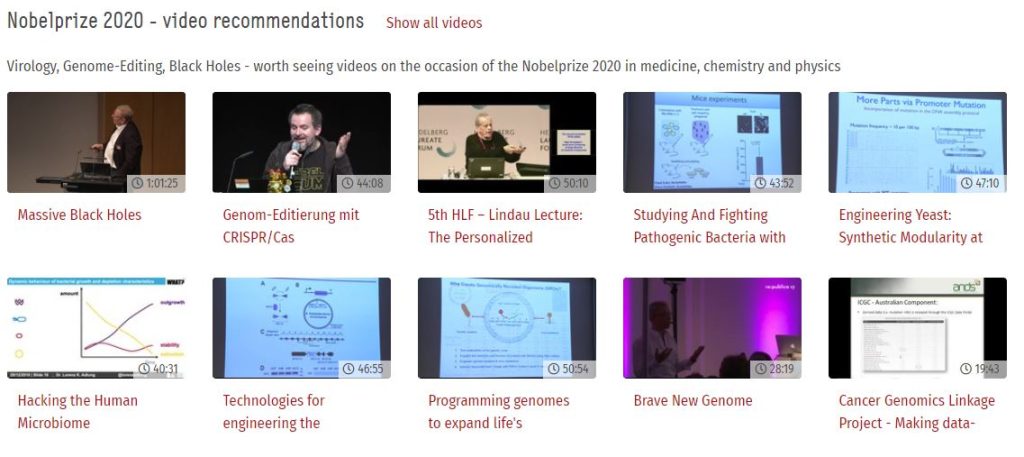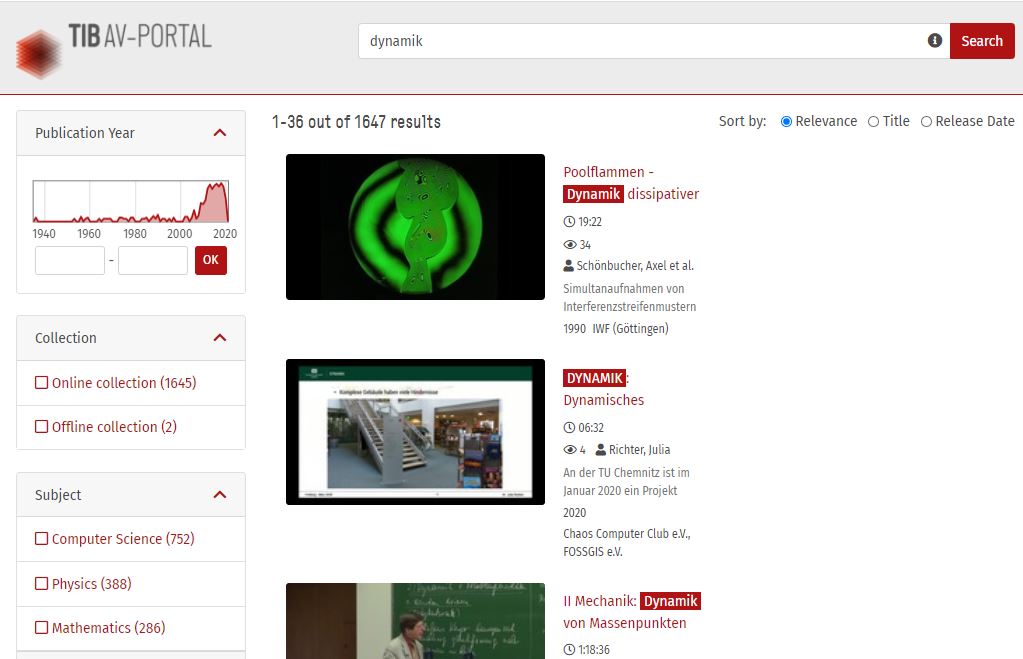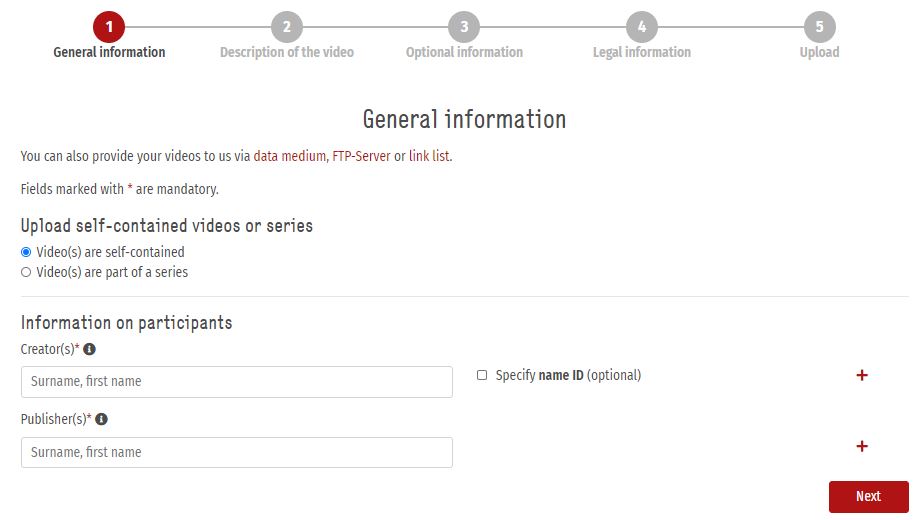More user-friendly – more functional – more dynamic. About the continuous and agile development of the TIB AV-Portal
The TIB AV-Portal is the video portal of the German National Library of Science and Technology (TIB). At the moment it has almost 30,000 media in its stock (as of November 2020). The AV-Portal focuses on science and technology. In addition, there are numerous other subject areas such as ethnology, medicine or economics and social sciences. The scenes, speech, text and images contained in the videos are automatically analyzed. The videos can be permanently cited using a Digital Object Identifier. In addition, the videos are archived for the long term and linked to further information such as scientific articles, research data or author IDs.
The AV-Portal was developed by the Lab Non-Textual Materials at TIB together with the Hasso Plattner Institute for Software Systems Engineering from 2011 to 2014. In spring 2014, the AV-Portal went online and since then has been operated by yovisto GmbH until 2020 and further developed according to TIB specifications. At the end of 2020, the portal was completely migrated to TIB.
In September 2018, the Scrum team of the AV-Portal was formed at TIB, which consists of four developers, a Product Owner and a Scrum Master (see about the Scrum framework). The team works agile and by now implements all implementations on frontend and backend independently and self-organized. In the following I would like to introduce some of the most important milestones and features that the Scrum team has realized since September 2018.
More dynamics – modernization of the start page
The start page has been redesigned significantly. The newest and most popular videos are displayed in separate blocks. Video recommendations are provided based on user history. Certain collections of the AV-Portal are now curated by an editor according to current topics and offered on the start page. A slider has been integrated to suggest current topics and videos and to draw attention to services of the AV-Portal. In addition to the articles of TIB Blog, the tweets of the Twitter channel are also displayed. The start page has thus become more vivid, more dynamic and more up-to-date and offers users considerably more search access.

More functionalities on the detail page
There have also been some changes on the detail page since the Scrum team was founded: The video can be shared via social media, permalink or embed code (HTML). The playlist shows all other parts of the video series. The metadata of the video is offered for citation in the formats BibTeX, RIS or text. Via plugin the metadata can also be imported directly into a literature management program like Citavi or Zotero. It is shown how often the video has been played. The publisher logos were integrated on customer request.

Greater ease of use for the media player
The media player has been adapted in detail in several places to make it more user-friendly. The playback speed of the video can be accelerated or slowed down in quarter steps. Users can jump forward or backward in 5-second steps using the arrow keys. After playing the video, users can also choose to watch it again or jump right to the next video. The next video is announced by title and image. The automatic playback of the next video can also be switched off. The playbar has been made slightly transparent and is automatically hidden when inactive.
Better overview in the hit display
More information is shown in the hit display: duration, authors and play count of the video as well as year of publication, publisher and abstract. The thumbnail image has been enlarged and shows a video preview when the mouse is moved over the image. Also, more hits – 36 per page – are loaded.

Enhancement of search and analysis functions
Users can filter the videos according to time periods for the year of publication and the length of the video. Metadata such as series title, authors & contributors, publisher, subject area and keywords were linked on the video detail pages, so that further searches can be triggered with a click. The search has been changed to the minimum match method so that it „forgives“ some typos when entering several search terms. In addition, the open source software PySceneDetect (scene recognition) was integrated, which replaces a proprietary video analysis from an external partner.

Display of series
The series have received their own page in the AV-Portal. They also appear in the playlist on the detail page and can be integrated on the start page. Currently, the Scrum team is working on the search for and within series.
New user interactions
Within the DELFT project (Digitalization of the Ethnological Film Collection), the ethnological film collection of the former Institute for Scientific Film (IWF) was digitized on behalf of TIB. Depending on the rights situation, the videos can be found in the online/offline stock of the AV-Portal and are continuously made available for research and scientific use. The technical requirements of the DELFT project were implemented by the Scrum team (see DELFT online stock). In addition, a button was integrated in the upper right corner of all videos and on all pages, with which videos can be added to a watch list. The watch lists can be shared. Finally, the form for uploading videos has been restructured – from a long vertical list to separate clearly arranged tabs.

More performance and less external dependencies – migration of frontend and backend
The frontend of the AV-Portal was migrated to the TIB infrastructure in 2019; the backend was migrated in 2020. This enables the Scrum team to carry out all implementations on the frontend and backend independently, so that there are no more external dependencies. The frontend essentially includes the graphical user interface and search of the AV-Portal, while the backend contains the numerous video analyses (including scene, voice, text and image recognition). The backend has become much more stable and has a higher speed due to the migration to the TIB infrastructure. Videos that failed in the analysis are automatically reprocessed. The backend is operated in a Kubernetes cluster. Kubernetes is an open source system for automating the provisioning, scaling and management of container applications. Thus, the system stability was increased and installation as well as operation was greatly simplified. In keeping with the modern and agile DevOps movement, operation is carried out by the development team itself. In the future, the frontend will also be operated in Kubernetes.
Current topics
Current strategic topics are scaling the frontend as well as integrating the frontend into the Kubernetes cluster. These are necessary preconditions for the provision of a frontend instance of the AV-Portal within the FID BAUdigital project.
... ist Product Owner des TIB AV-Portals // ... is product owner of the TIB AV Portal




0 Antworten auf “More user-friendly – more functional – more dynamic. About the continuous and agile development of the TIB AV-Portal”